
Original Link: https://www.anandtech.com/show/1585
Consumer Electronics Show 2005: AT's Coverage
by Anand Lal Shimpi on January 10, 2005 3:49 AM EST- Posted in
- Trade Shows
Going into CES this year I didn't really know what to expect. Last year's CES was what CES had always been, a Consumer Electronics Show with a few motherboard manufacturers scattered throughout the show. But also remember that last year saw the nail in the coffin for Comdex and most of the companies in the tech industry said that they would instead be at CES, showing off their "convergence" devices as well as some of their conventional PC technology products.
Well, walking the show floor I get the feeling that while some companies do get a clear impression of where we're headed, the vast majority are simply in a confused state of mind. For example, historically I've never found Microsoft's booths at any tradeshow interesting, but for the first time ever at this year's CES, I'd say that the Microsoft booth was by far one of the most interesting. Then I look at other more consumer electronics based companies and I see that they're here at CES promoting the same unintelligent CE devices that they have been for the past several years, maybe with the addition of "HD" to their name.
For years Intel and Microsoft have been talking about this "convergence" between PC technology and consumer electronics and for the first time ever you can actually truly see it happening on a much larger scale than just being able to play your MP3s over your home stereo. At the same time, despite the huge movements forward in this idea of convergence, walking the halls of CES tells me plain and simple that the road to convergence is still a very long one. There are far too many companies that still don't get it and there's still a lot of network infrastructure that needs to be in place before companies can really begin to offer some cooler convergence products.
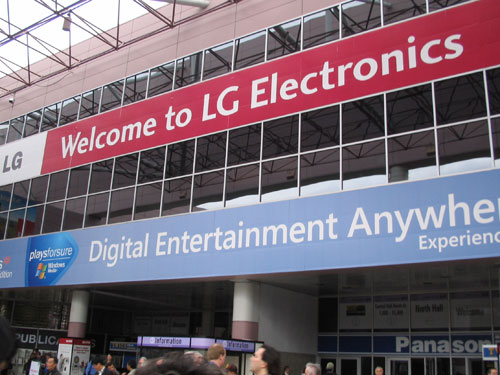
So this year's CES ends up being far from a smoothly integrated show featuring consumer electronics, PC technology and the futures of both. Very few showcases and demos actually presented the convergence of all three, with far more displaying segregated products falling into each individual category. Not that this is a bad thing, it's just more of a wake up call that there's still a lot of work to be done.
That being said, the CES show itself this year is absolutely massive. Transportation to and from the show and meetings is basically impossible unless you have a car or are close to a monorail station. The upwards of 120,000 CES attendees have put a full strain on the Las Vegas taxicab system, making waiting for a cab during CES show hours a 1.5 - 2 hour ordeal. The organizers of CES will make things even more difficult next year as they revisit the Comdex legacy and add a third location to CES - the Sands Expo Center connected to the Venetian hotel in Las Vegas (which always proved to make scheduling meetings and covering the show fun).
With the show over and the AnandTech team out of Vegas, we can finally bring you coverage of the highlights of this year's Consumer Electronics Show.
Dual Core at 3.0GHz - Working Now
Starting off with the PC side of things, Intel was far more present at CES than AMD, which is what we expected given the higher level of involvement from Intel on the CE front.
During Craig Barrett's keynote on the first day of CES, one of the demos involved a media center PC (not MCE) showcasing an interesting method of navigating video content on the PC: using hand gestures.
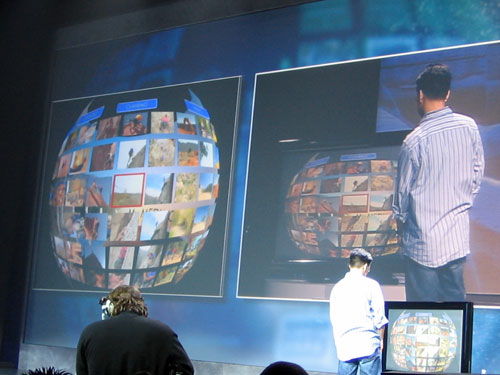
The spherical image on the left was basically your channel listing, with each one of those little windows displaying a full frame rate video stream, the sum of which was all of the channels you could possibly watch. You could rotate the channels left or right by moving your hands in the appropriate direction, and you could select which channel you wanted to watch by pointing at it. The demo wasn't flawless but Barrett promised that the technology being demoed was something that would be available 12 months from now.
Whether he was talking about every aspect of that particular PC or just its dual core Smithfield based processor is up to anyone's speculation. Unfortunately Barrett didn't disclose too much about the CPU specs of the system other than it was a dual core unit.
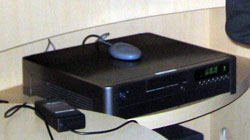
Intel's Dual Core Smithfield Pentium 4 x30 platform with both cores running at 3.0GHz
Luckily at Intel's booth we were able to get a glimpse of said system and found out it was a fully functional 90nm Smithfield running at 3.0GHz. It's about time Intel had a running dual core demo, it was beginning to look like only AMD would be able to pull off dual core.
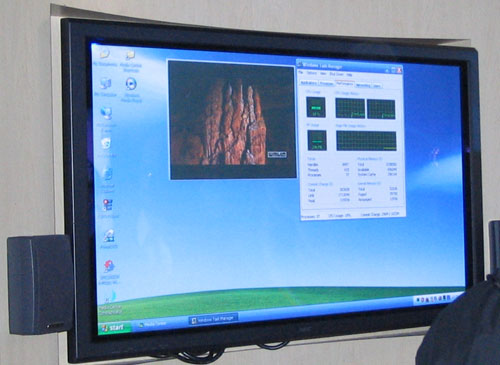
Task Manager shows the two cores in action, note that there is no Hyper Threading on Dual Core CPUs so there are only two physical CPUs listed
Bring up of Intel's dual core seems to be pretty strong and everything is on track for a release at the end of 2005. We did get confirmation that the dual core CPUs would not work on existing 925X and 915 based motherboards, not without changes to their design. While we would normally be disappointed, the fact of the matter is that very few people bought 925X and 915 based motherboards so it's not too big of a deal.
We also asked Intel if they had any tricks up their sleeve for regaining the definitive performance crown this year - unfortunately their answer was no. It appears that a lot of upper management at Intel is a bit astounded by the success of Centrino, noting that it is a full blown success achieved on features and a full platform and not purely performance. There's also this idea that performance right now is good enough for most desktop users, and fighting over a handful of percentage points that won't be appreciated is a silly battle to win. So for the near future at least, it seems like what we've published in previous Intel roadmaps is all we're going to see from them. What remains to be seen is if AMD will be able to continue to convert Intel's lack of focus on absolute performance leadership into marketshare for AMD.
Intel also seems confident that dual core will bring noticeable performance gains to the desktop user, citing that while application support may not be there that the OS and multitasking experiences will be greatly improved to the point that once you've used dual core you'll never go back. Having personally used multiprocessor systems as my main workstations for years now I can attest to the benefits of multiprocessors, however more than anything we're going to need a good way of quantifying the performance benefits with something else than an Intel script that runs an antivirus scan while you defragment your hard drive.
Intel's Pentium 4 600 Series running Windows XP x64
Although it wasn't heavily advertised, Intel had a 925XE system running the new Pentium 4 600 series with a 2MB L2 cache in their booth. As you undoubtedly know by now, the Pentium 4 600 series is still a 90nm Prescott but with twice the L2 cache, EMT64 (x86-64) support as well as all of the features available in the current 500 series.
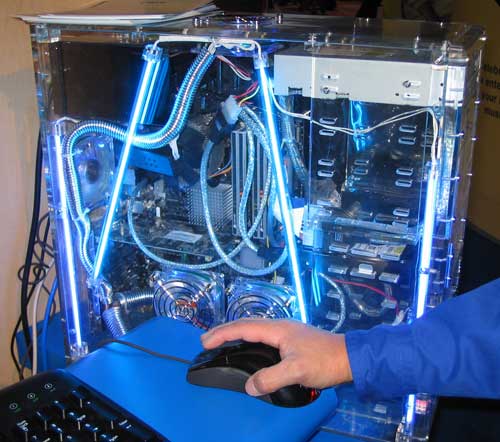
The Pentium 4 600 demo system
Quite possibly the most interesting part of the demo was that it was running a version of Windows XP x64, a feature that we've never really seen Intel promote much publicly.
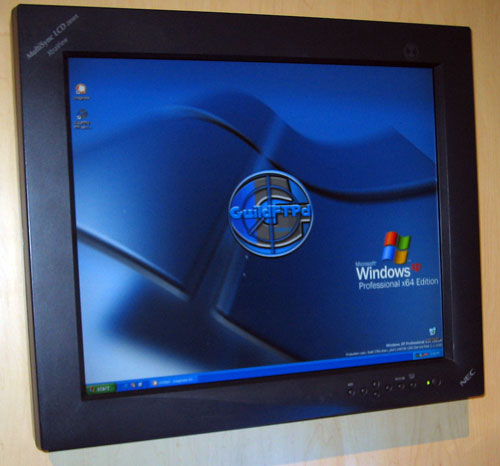
64-bit Windows XP in a public Intel demo? We thought we'd never see the day
The demo wasn't anything too impressive; it was a demo of a Nikon D2H camera with a massive 802.11 cradle that attached to the base of the camera and FTPed images as they were taken to the Pentium 4 6xx system running Windows XP x64.
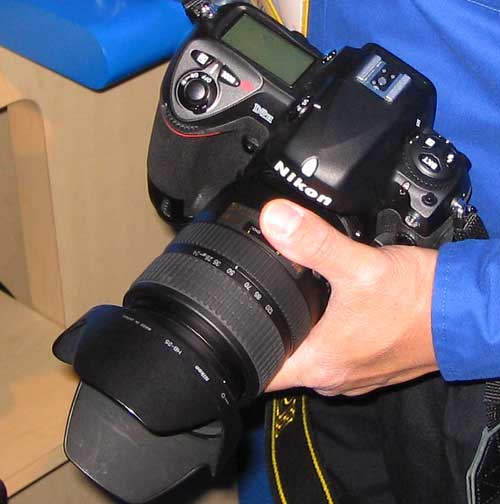
A normal Nikon D2H...
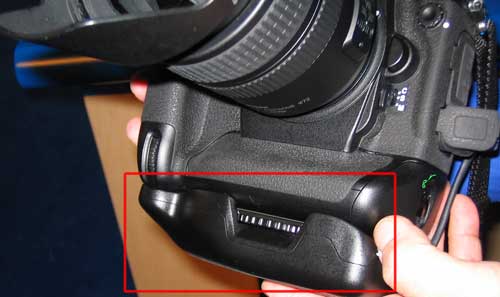
With a massive 802.11 base stuck on to it, not too elegant. Eventually Nikon will integrate the wireless functionality into their cameras.
Intel's Sonoma Platform
Intel's Sonoma Platform, the codename for the soon to be released Centrino update, was also talked about quite a bit at Intel and the show.
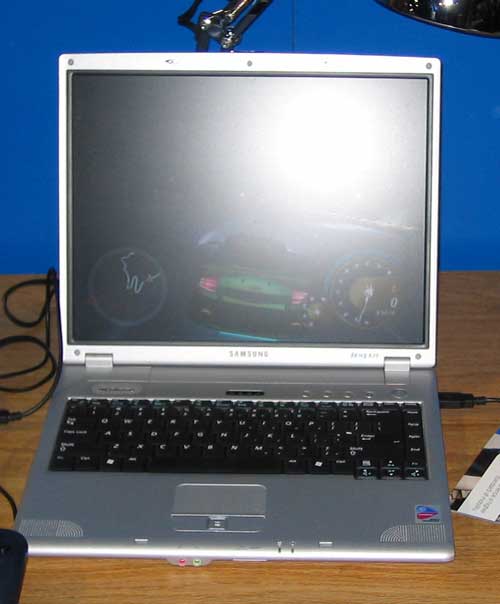
Sonoma incorporates the following:
- Intel's Alviso chipset (mobile 915 chipset)
- 533MHz FSB Pentium-M processors
With the new chipset comes improved integrated graphics (thanks to the 915G's integrated graphics core), dual channel DDR1/DDR2 support, 533MHz FSB support, PCI Express support and HD Audio support.
The chipset offers both PCI Express x16 and x1 support for graphics and peripherals, identical to the desktop 915.
The inclusion of dual channel DDR1/DDR2 support is tremendous for performance as the previous generation 855GME chipset was still only a single channel platform for Centrino. Intel stated that going forward the split between DDR1 and DDR2 Sonoma designs is about 50/50, given that the power requirements of mobile DDR2 and mobile DDR1 are quite similar. The platform supports up to DDR2-533, but we'd expect that fewer companies would use the speed just yet. We asked some memory manufacturers and they seemed to think that a 50/50 split between DDR1 and DDR2 Sonoma platforms (based on their shipments of DDR2 to Intel's customers) would be definitely possible by this summer.
Intel will also be releasing a smaller form factor version of the Alviso chipset with a much smaller package for use in very tiny ultra portable laptops. The smaller version of the chipset will lack a PCI Express x16 interface to reduce pin count and may only be single channel.
None of the Sonoma platforms on display were too impressive, but we did see units from ASUS and ECS among the usual suspects.
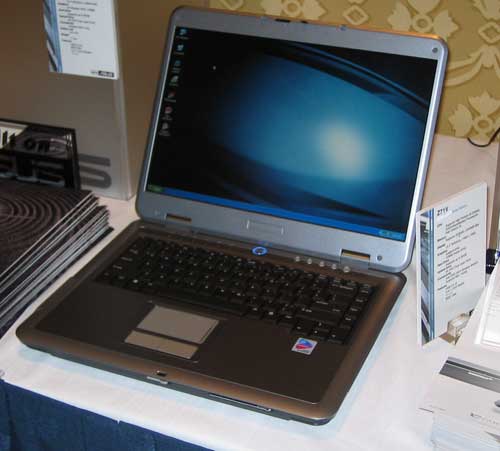
ASUS' Sonoma platform
ECS had a large footprint but cool-looking Sonoma notebook:
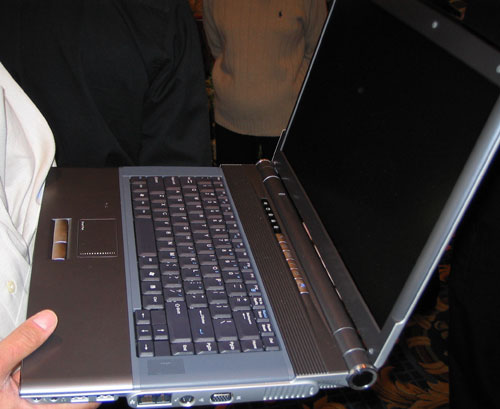

Reasonably thin considering its footprint

...and interestingly textured
Battery life is expected to be similar to current Centrino designs.
Sonoma Media Center XPC from Shuttle
Although it's not yet ready for release, Shuttle put together a set-top style HTPC/XPC based on the Alviso chipset for use in Media Center appllications.
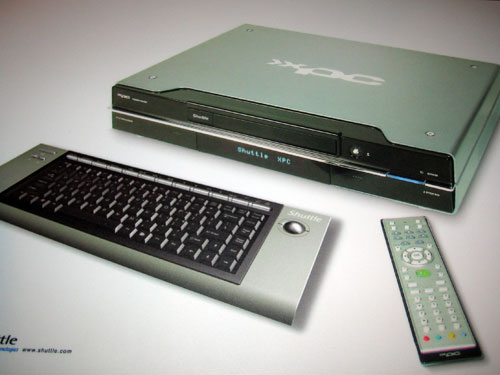
A rendering of Shuttle's MCE XPC including their new MCE remote
Due out for release in the 2nd or 3rd quarter of this year, the system uses DDR1 SO-DIMMs and has room for an internal 3.5" HDD as well as a removable external 2.5" HDD.
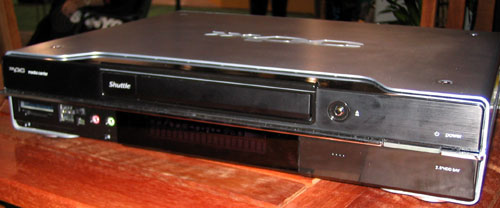
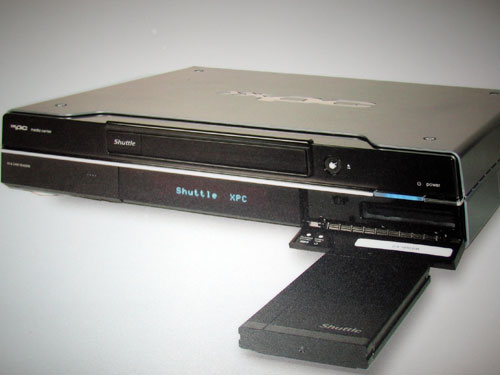
Shuttle's removable 2.5" HDD bay in action
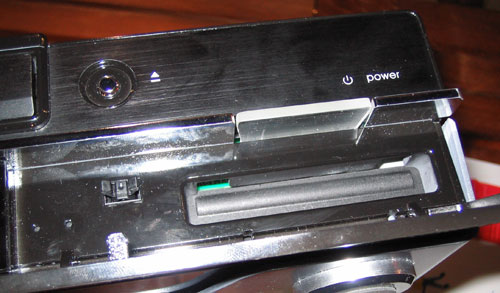
The 2.5" HDD bay prototype in action
The XPC is obviously designed for a more set-top applications and thus will also feature a cable card reader as well as HDTV output. The next version of Microsoft's Windows XP Media Center Edition due out in Q3 will support cable card and content protected HDTV content over digital cable services, making this device actually useful from a HDTV standpoint.
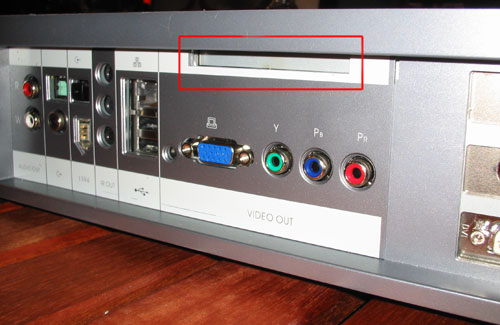
A cable card slot
We are very impressed with Shuttle's leadership demonstrated with this design, especially when most manufacturers are too afraid to even launch a desktop Pentium M product. We would strongly encourage them to bring a Alviso based XPC in their normal XPC form factor as its dual channel memory setup would definitely make it a solid desktop competitor.
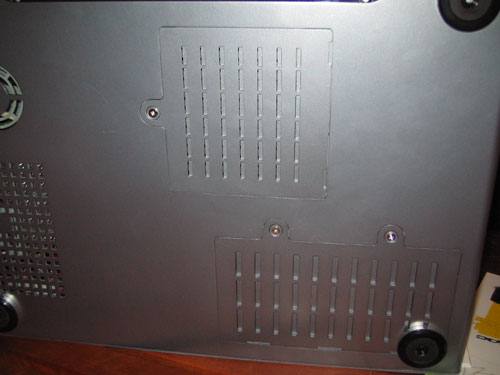
Memory and CPU can be upgraded from below
Shuttle's nForce4 SFF
Shuttle also had a nForce4 SFF on display, while the externals are similar to current generation Shuttle XPCs the internals are what make Shuttle's latest interesting.
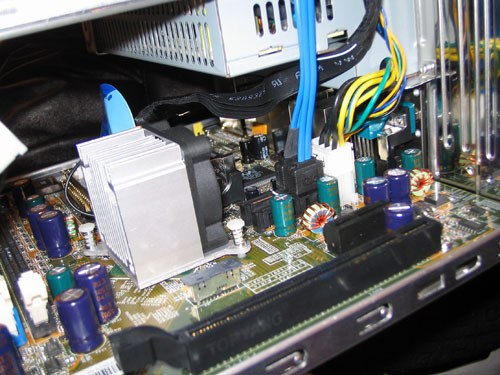
The XPC has two PCIe slots, a x16 slot and a x1 slot. A future version of the XPC will feature two x16 slots for use in SLI configurations, impressive for a SFF.
Due to popular demand Shuttle also incorporated a VIA Envy24 audio controller in their nForce4 SFF to address concerns about audio quality.
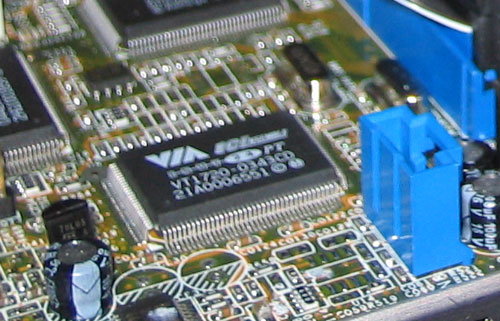
ASUS' SFF
ASUS was showcasing an 865 based SFF with an interesting chassis design that provided extremely easy access to internals.

Unscrewing a single thumbscrew and popping off the front panel is all that's necessary to gain access to the inside of ASUS' SFF.
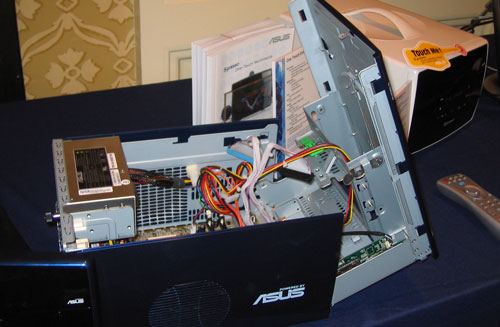
The design is interesting, but as an 865 solution it's still a bit dated. We'd like to see something using NVIDIA's nForce4 chipset instead.
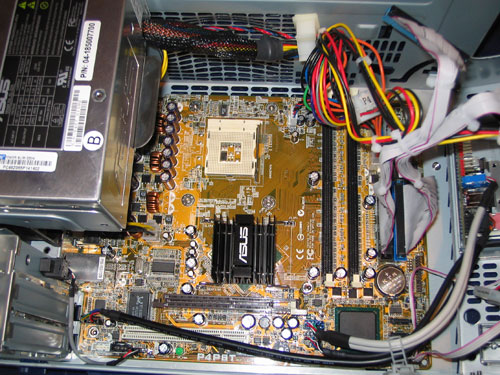
The other issue with the SFF is that it has a fairly low powered PSU meaning it can only support a maximum of a GeForce 6600GT and not any of the higher powered GPUs like a 6800GT.
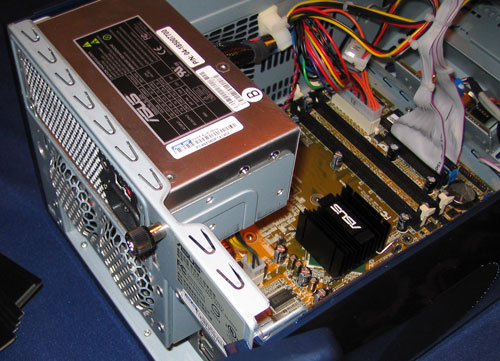
1080p DLPs Coming in April
Texas Instruments was quite eager to showcase all of the DLP based rear projection TVs that use their DLP chips.
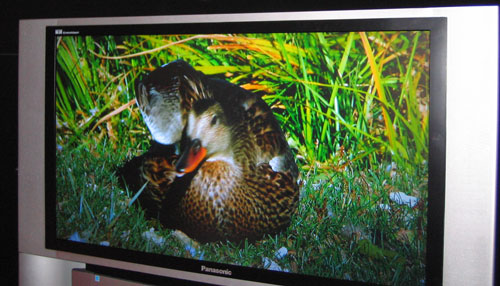
Panasonic's 720p DLP
The most exciting thing at the TI booth however were the handful of displays that used TI's new xHD3 DLP - their first 1080p (1920 x 1080 progressive) DLP solution.

A 1080p image
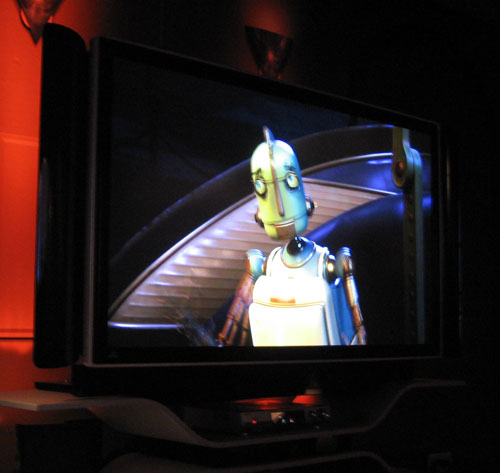
A 70" 1080p DLP
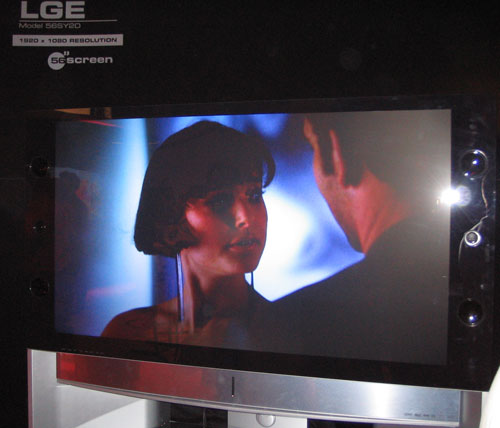
LGE's 1080p display
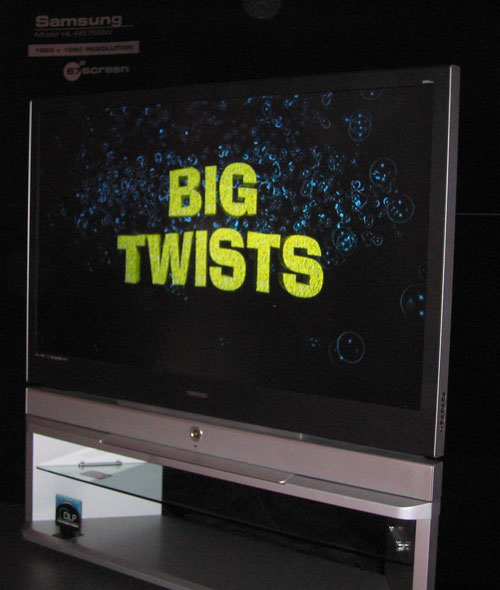
Samsung's 67" 1080p DLP priced at over $6000 and available in April
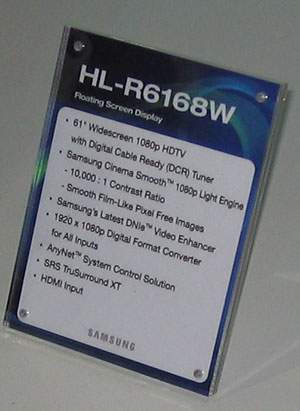
Samsung will also offer a 61" 1080p DLP
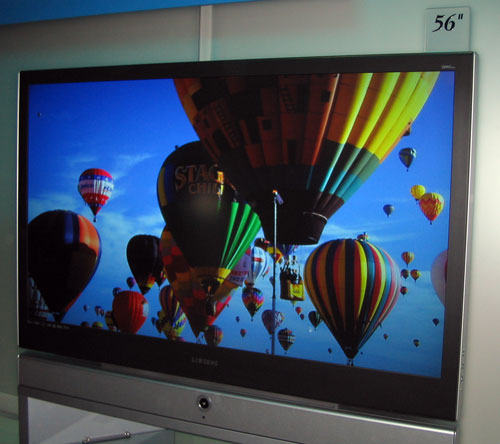
Samsung's 56" 1080p DLP also due out in April
TI also gave us a rundown of their current DLP lineup to clear up any confusion there may be over the cost/features of various TI solutions in DLPs today:
HD2 - TI's older DLP measures 0.8" diagonally and is a rectangular grid 720p DLP.
HD2+ - A higher contrast version of the HD2. The higher contrast was made possible through process improvements allowing for closer positioning of the individual mirrors, smaller mirrors and darker coatings to help absorb unwanted light inside the DLP.
HD3 - A 0.55" diagonal die not on a rectangular grid using half the mirrors of the HD2/HD2+ but still a 720p solution. Using mirrors that can move and stabilize at twice the speed of the HD2+ solution, TI was able to use each mirror for two pixels in the HD3 chip by shifting each individual mirror very slightly and very quickly to paint two pixels (think of it as a serial DDR approach to DLPs). The benefit of using half the mirrors is that it drives down the size of the DLP (0.55" vs. 0.8") and thus reduces the price of the TVs. The DLP also somewhat overlaps the two pixels it paints using a single mirror to get rid of pixelization, to provide for a smoother, more film-like image (which some may or may not prefer). TI calls this 2 pixels per mirror technology their Smooth Picture Technology, so whenever you see that phrase used it means that the TI DLP is only using half the necessary mirrors and using each mirror to drive 2 pixels.
xHD3 - A larger chip with a 0.85" die, the xHD3 is basically a HD3 that does 1080p. It also features Smooth Picture Technology.
Samsung displays based on the xHD3 DLP will be out in April, and available in sizes ranging from 56" up to 67".
7" Thin DLPs from RCA/InFocus
RCA and InFocus partnered up to produce the thinnest rear projection DLP TV at the show - their displays are only 7" deep (compared with Samsung's displays that are 18" deep).
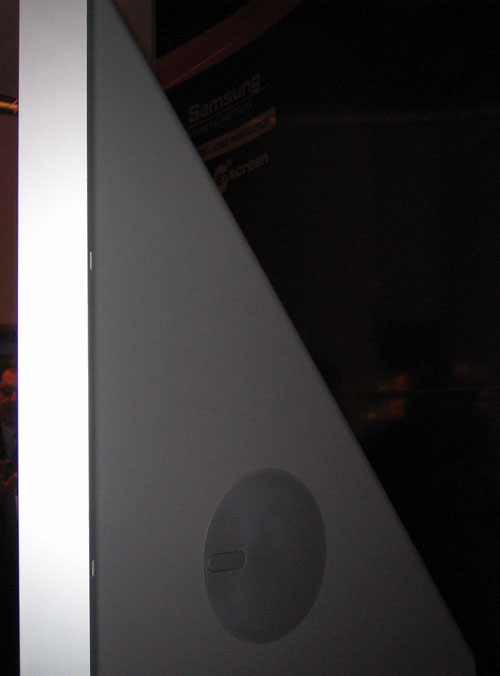
Samsung's DLPs are 18" deep
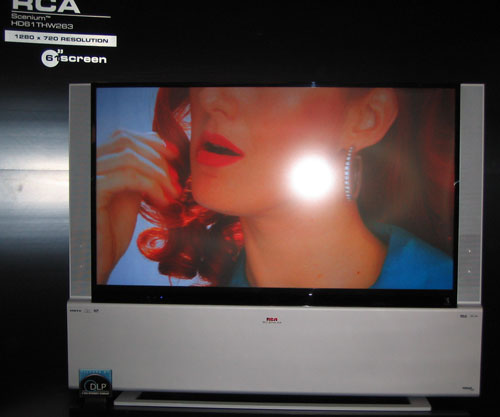
RCA's 720p DLP is 7" deep
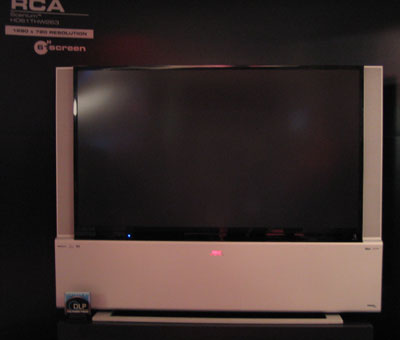
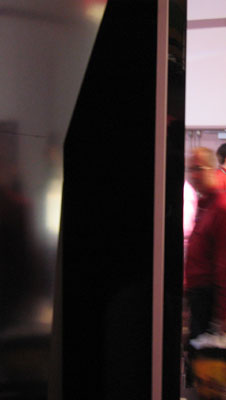
Only 7" deep...we're approaching Plasma thickness
Windows Mobile Phones
There were several Windows Mobile based cell phones that were on display at the Microsoft booth.
While many were bulky there was one Audiovox phone that truly stood out:
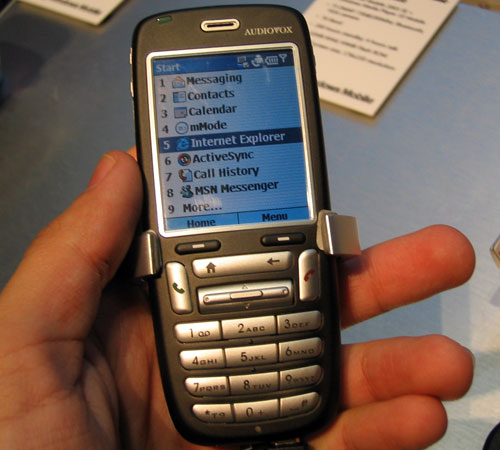
Not ideal for typing on, the Audiovox SMT5600 would be perfect for just synching your contacts and other information from your Windows based PC. It's small, light and very easy to use, we were quite impressed by it.
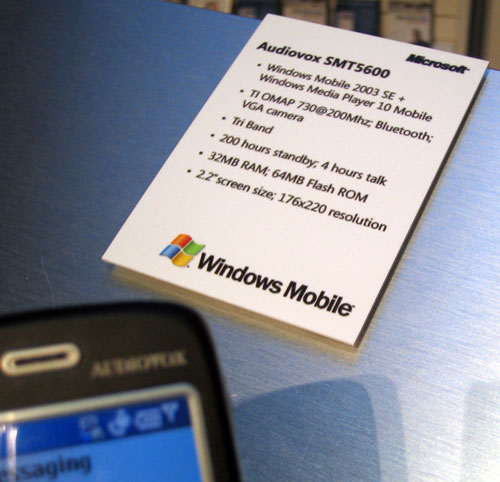
Motorola showcased a Windows Mobile based phone, the MPX, that could flip open two different ways:
The phone supported both 802.11 networks and GSM networks, also a nice feature.
However, like many Windows Mobile based phones, we felt that the phone was a bit too bulky and the interface a little too cumbersome for our tastes.
Games
There weren't too many gaming related booths at CES but there were a few points of interest.
Battlefield 2
The Battlefield 2 engine was also on display on the Microsoft booth, although the graphics weren't tremendously impressive the engine looked like it would be a good continuation of the Battlefield series.
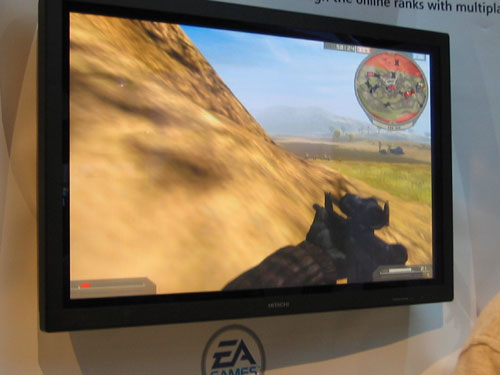
Prince of Persia
A Ubisoft representative made two interesting announcements at Barrett's keynote: Prince of Persia: The Warrior Within is both Hyper Threading enabled and 10 ft UI optimized. The Ubisoft representative didn't indicate how HT was taken advantage of or if it was even available without a patch, but it is interesting to note given the dual core future that's quickly approaching.
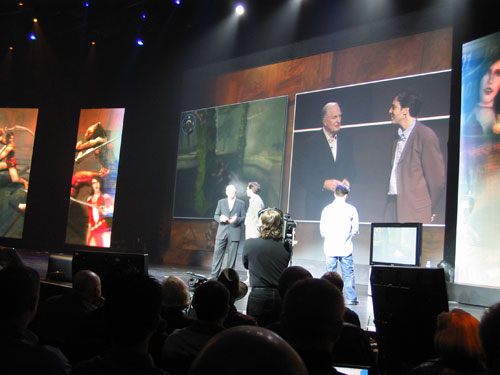
AMD's Booth: A lot of Alchemy and Flash
We mentioned that AMD was curiously quiet throughout the show, but their reasonably large booth was tucked away in the South Hall of the Las Vegas Convention Center. Expecting to see a dual core demo or a lot of Athlon 64 MCE machines, we were quite surprised when all we saw were a lot of Spansion flash and Alchemy based devices overshadowing a handful of Athlon 64 systems and notebooks.

FIC has been steadily retreating from the retail channel and will continue to focus exclusively on the OEM market. The future direction of FIC is a bit of a shame considering that FIC produced some of the first, strongest and most unique solutions for AMD or non-Intel customers. We were surprised to see a lot of FIC products at the AMD booth, an interesting attempt to compete with the digital home devices shown off at the Intel booth but definitely not executed as well.
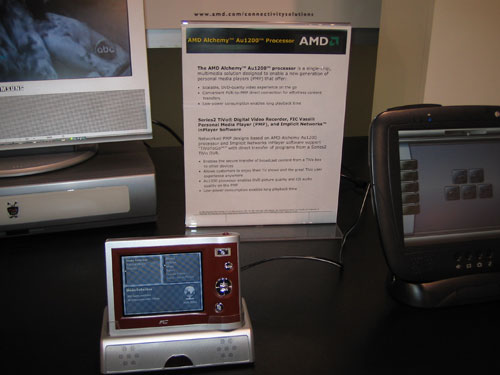
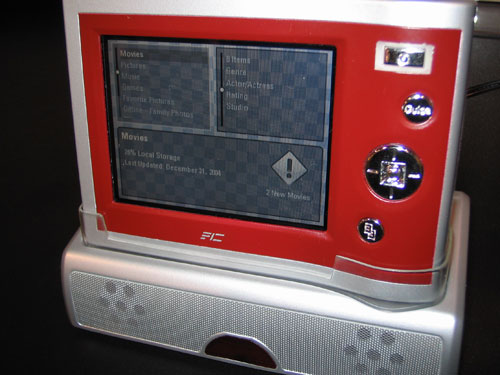
FIC's Alchemy based media player
We did get a bit of information about AMD's dual core - the first Socket-939 dual core Athlon 64 processors will be priced at $700 when they are released later this year, so start saving up.
Transmeta Demos 90nm Efficeon at 2.0GHz
Despite the negative news reports regarding Transmeta in the mainstream media, the unique chip manufacturer actually had a more interesting (from a PC perspective) booth than AMD.
The most impressive demonstration at Transmeta was of a 2.0GHz, 25W, 90nm Efficeon. The clock speed alone was impressive, considering that the fastest Efficeon demo we'd seen previously was at 1.6GHz. The other part of the demo that was impressive was the test itself: a 6Mbit WMV HD playback test with no GPU assistance.
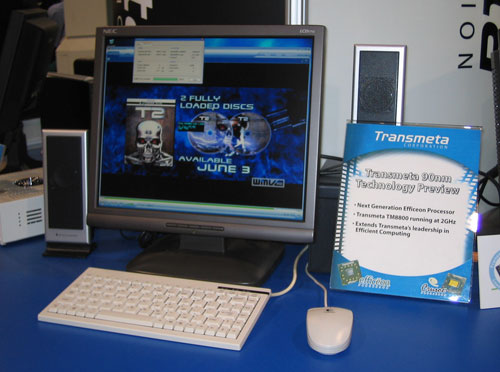
WMV HD (1080p) playback is one of the most stressful playback tests you can run on a PC, and the fact that the Efficeon is able to handle it is a huge feather in Transmeta's cap.
The demo also monitored clock speed, which ranged from 1.2GHz up to 2.0GHz, with the majority of the playback happening with the CPU at 1.4/1.6GHz. While 1.6GHz Efficeon products are available today, 2.0GHz offerings should be hitting the streets before the end of the year. For the first time we were actually impressed with the level of performance from a Transmeta CPU, but we'd actually like to put it head to head with a Dothan based Pentium M to see how strong the performance really is.
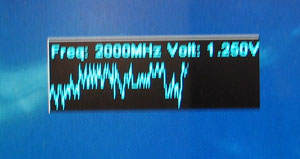
According to Transmeta, the 2.0GHz Efficeon is comparable in overall performance to a 3.0GHz Pentium 4. The WMV HD decode test does back up Transmeta's claims, but it's still a tough pill to swallow given Transmeta's prior performance history.
Transmeta had a Sharp ultraportable on display that was also quite impressive:

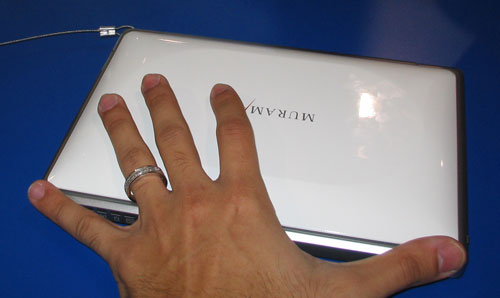
The notebook is extremely tiny but has a keyboard that is barely manageable if you have small hands. But if you've got average sized hands then you'll find yourself cramped for space and if you have big hands then this is definitely not the notebook for you.
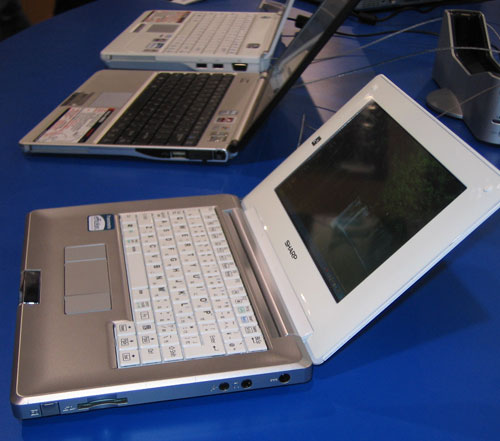
The screen itself is pretty small and it can be hard to read the default sized text in Windows:
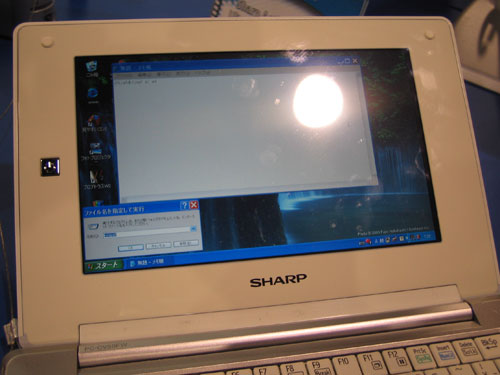
But you can't beat the portability of the notebook, something that Intel has come close to doing with the Pentium M but most of those designs end up being far too conservative compared to what we've seen from the Transmeta camp:

There was an Efficeon media center based platform at the Transmeta booth as well, but it ran MythTV and not XP Media Center Edition. We are curious to see if the Efficeon performs well enough to run a MCE PC as smoothly as some of the higher end AMD and Intel offerings.
The CPU and Chipset Marketplace
When given the opportunity to sit down with the leaders of the Taiwanese motherboard market we're always able to get a good idea of who's really leading in terms of industry marketshare. We asked our contacts at all of the motherboard makers we met with what they were seeing in terms of CPU marketshare and chipset marketshare in 2005.
We talked to one motherboard manufacturer whose motherboard shipments were 60% AMD and 40% Intel. The rest of the motherboard manufacturers in Taiwan are still shipping more Intel than AMD but we're seeing a continued shift towards a 50/50 AMD/Intel split when it comes to motherboard shipments. By the end of Q2 all Socket-478 CPUs will have dried up, meaning that anyone looking for an Intel platform will be forced to move to 915 or 925X(E), which should obviously increase shipments of those two platforms but may also increase the number of AMD platforms sold.
ATI's chipset penetration is basically nothing amongst the Taiwanese motherboard manufacturers, despite ATI's efforts to brand the Radeon Xpress as an enthusiast solution. Part of the problem is ATI's previous history of chipsets and the other part of the problem is NVIDIA - the Taiwanese motherboard manufacturers are quite happy with nForce4 on the AMD side and they'd rather not produce any more Intel motherboards that won't sell, so ATI loses out.
VIA's best ally among the Taiwanese motherboard manufacturers is currently shipping around a 60/40 split when it comes to VIA vs. NVIDIA chipsets. The rest of Taiwan however appears to be more along the lines of 50/50 between VIA and NVIDIA. The manufacturers we talked too indicated that as soon as nForce4 was available on a more widespread basis that their AMD motherboard shipments would soon be much stronger in favor of NVIDIA.
VIA appears to be focusing on their Pentium 4 chipsets which we didn't hear or see much support for from the Taiwanese makers when we met with them at CES. Right now it seems like NVIDIA will be the chipset maker to watch out for in 2005, especially with the introduction of their upcoming Intel chipset.
NVIDIA's Intel chipset will support DDR2 and may actually bring some much needed excitement to the Intel platform. The entire Sound Storm division at NVIDIA has been shut down and thus NVIDIA's Intel solution will have HD Audio support, but we will not see the return of Dolby Digital Encoding support or NVIDIA's Sound Storm DSP.
A Single BTX Motherboard
Despite the perfect fit the BTX form factor (especially its pico and micro versions) would be for convergence PCs, at this point Intel is basically not pushing BTX at all. You couldn't even find mention of the acronym BTX anywhere in Intel's booth.
We saw a single BTX motherboard on display at the show and it was in ASUS' suite:
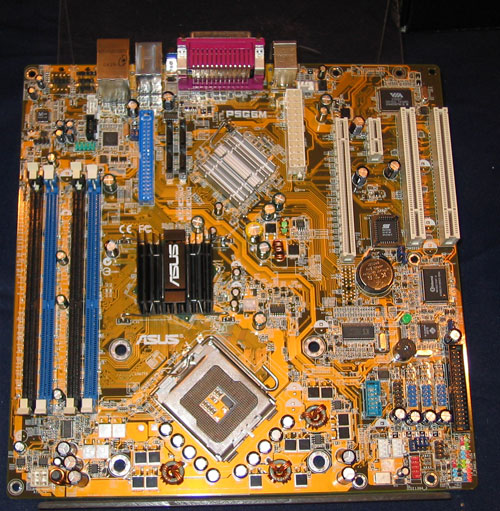
The P5G6M is a Micro BTX solution based on Intel's 915G chipset, however ASUS stated that they won't bring it to market until they have a customer for it - which they presently do not.
Most motherboard (and case) manufacturers we talked to had no plans to bring BTX solutions to market anytime soon. The motherboard manufacturers indicated that the next generation of Intel chipsets, Lakeport and Glenwood, may have more BTX designs, but for now don't expect BTX to be present at all.
ATI and NVIDIA Availability
Despite what ATI promised, none of the Radeon X850 line are available, even as we start 2005. The Radeon X850 XT will be available at the end of January with the X850 XT PE available a week later in February.
There is no word on the Radeon X850 Pro, which confirms our suspicions that ATI hadn't thought their positioning through on that part before announcing it.
Even after the X850 line is officially launched, we are told that availability will be extremely limited.
The Radeon X800 will be available in the first week of February, with the X800 XL following a week or two later. These dates were all provided by ATI's partners and not ATI themselves, so hopefully the accuracy will be higher than what we were told by ATI.
As far as AGP versions of all of these cards go, it looks like it won't be until mid-March before we see AGP versions of ATI's latest GPUs. On the low end, ATI's answer to NVIDIA's Turbo Cache will be shipping in around 6 - 8 weeks.
NVIDIA's PCIe 6800 series will still be limited in availability for the foreseeable future, we were even told by one manufacturer that the availability problem wouldn't be resolved until the 2nd half of this year.
Creative's Wireless Headphones
Creative Labs had one announcement at the show, a set of wireless headphones for use with the Zen Micro.
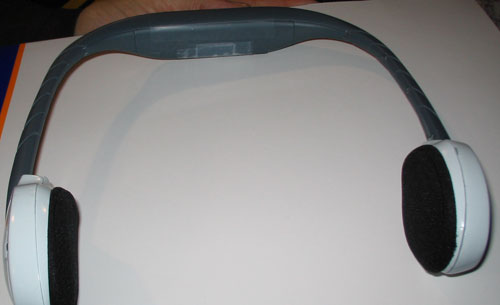
When released, the headphones will have a small dongle that will plug into the Zen Micro that will act as a wireless transmitter to the headphones. Creative stated that the primary advantage of their wireless headphones was that they did not communicate over radio frequency and thus had fewer interference issues.
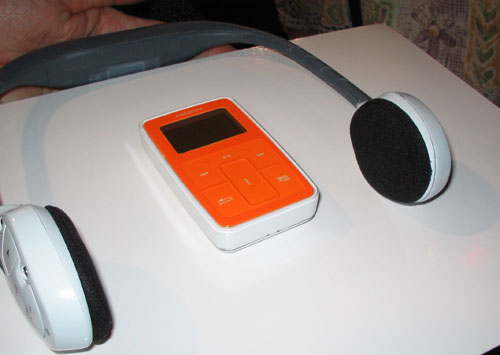
Creative didn't let us know how the wireless headset would receive data but we'll most likely find out later this year closer to its release.
The prototype shown at CES was a bit bulky and we'd expect Creative's styling department to go to work on it far before its release.
MGE's Quiet Powersupply
MGE, the case manufacturer, was showing off one of their new HTPC cases. Unfortunately the case on display had none of the more interesting features that would make it into the final product such as sound insulating foam:
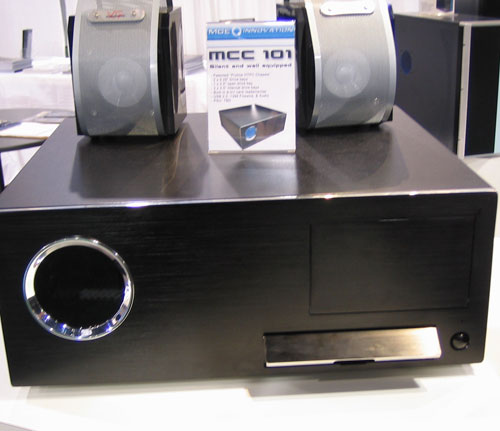
MGE also demonstrated a more sleek lineup of cases, a welcome change from the overly busy gaming cases that we've seen far too much of lately:
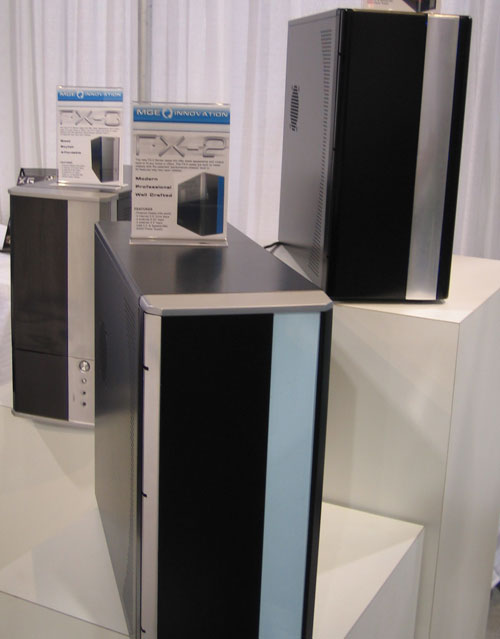
Quite possibly the most interesting product at MGE's booth was their Magnum power supply. A 600W/700W power supply designed around quiet operation thanks to its use of copper heatsinks and heatpipes, as well as a single very quiet fan.

The Magnum makes use of the increasingly popular detachable cabling, except MGE used the standard power supply connectors on the Magnum instead of proprietary connectors. The sample MGE had on display did not have any PCIe power connectors however MGE promised that at least one, maybe two, would be in the final version.
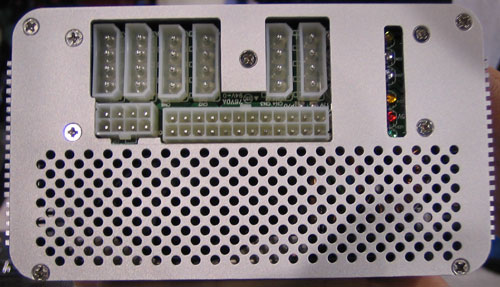
MGE also promised that the final version would have a display on the back that would provide PSU temperature, power consumption and voltage readouts, although the prototype had nothing more than a sticker representative of the aforementioned features.
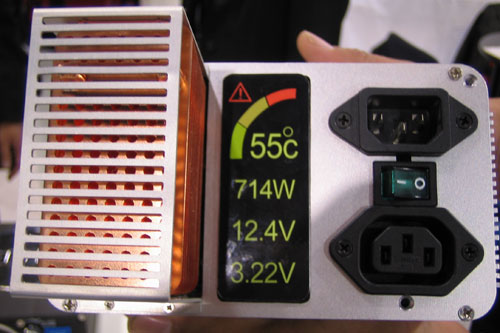
Final Words
This year's CES proved to be an interesting show but also acted as a good reminder that convergence is far from here.
While the past several conferences we've attended have always focused on consolidation in the industry, this year's CES was the first time we had heard companies talk about moving forward, rather than worry about declining sales. The industry still isn't out of the shadow of the once rapidly declining market, but the light at the end of the tunnel is finally shining through.
We'd say that overall, CES was a success but not without one major shortcoming. We still heard many cries for a dedicated PC technology show - CES did not provide the worthy Comdex replacement that everyone had hoped for. Either turn the Sand Expo Center into a PC technology showcase or maybe we'll have to fill the void with our own show in the Fall.







